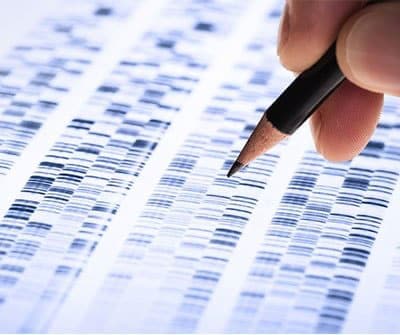Dentatorubral-pallidoluysian atrophy, commonly known as DRPLA, is a progressive brain disorder. The average age of onset of DRPLA is 30 years, but this condition can appear anytime from infancy to adulthood.
The signs and symptoms of DRPLA differ somewhat between affected children and adults. When DRPLA appears before age 20, it most often involves episodes of involuntary muscle jerking or twitching (myoclonus), seizures, behavioral changes, intellectual disability, and problems with balance and coordination (ataxia). When DRPLA begins after age 20, the most frequent signs and symptoms are ataxia, uncontrollable movements of the limbs (choreoathetosis), psychiatric symptoms such as delusions, and deterioration of intellectual function (dementia). It is described in more detail at Medline by the NIH.
Eye problems, tremors, sleep disturbances, sleep apnea, spasticity and problems with swallowing have also been reported in the literature. The clinical manifestations of DRPLA and the trajectory of decline are not fully understood and even in members of the same family, DRPLA can present differently.
Frequency
DRPLA is most common in the Japanese population, where it has an estimated incidence of 2 to 7 per million people.
CureDRPLA has identified families with DRPLA in more than 20 different countries from around the world. Although DRPLA is rare in the United States, it has been studied in a large African American family from the Haw River area of North Carolina. When the family was first identified, researchers named the disorder Haw River syndrome. Later, researchers determined that Haw River syndrome and DRPLA are the same condition.
Cause
DRPLA is caused by a mutation in the ATN1 gene. This gene provides instructions for making a protein called atrophin-1.
Although the function of atrophin-1 is unclear, it likely plays an important role in nerve cells (neurons) in many areas of the brain.
The ATN1 mutation that underlies DRPLA involves a DNA segment known as a CAG trinucleotide repeat. This segment is made up of a series of three DNA building blocks (cytosine, adenine, and guanine) that appear multiple times in a row. Normally, this segment is repeated 6 to 35 times within the ATN1 gene. In people with DRPLA, the CAG segment is repeated at least 48 times, and the repeat region may be two or three times its usual length. The abnormally long CAG trinucleotide repeat changes the structure of atrophin-1. This altered protein accumulates in neurons and interferes with normal cell functions. The dysfunction and eventual death of these neurons lead to uncontrolled movements, intellectual decline, and the other characteristic features of DRPLA.
Inheritance Pattern
DRPLA is inherited in a dominant autosomal manner, which means that there is a 50% chance of passing it down to the next generation. Usually, the CAG repeat expansion that causes DRPLA increases in size in each subsequent generation. This is called anticipation and it can lead to an earlier onset of symptoms.
Genetic counselling is the process of helping people understand and adapt to the medical, psychological and familial implications of genetic conditions such as DRPLA. Genetic counselors can provide information regarding family planning to help you understand the risks and options.
Burden
The inheritance pattern of DRPLA means that there can be multiple family members affected with DRPLA. It is common for a parent and one or multiple children to be affected at the same time. Therefore, the unaffected members have a lot of responsibilities as caregivers. Each individual with DRPLA has very different needs and these might change over time – thereby proving that in addition to the effects on individuals, family members and caregivers can experience emotional and physical burden of their own as well.
As the affected family member gradually loses functions, family dynamics change, and concerns for the future gain significance. The burden that individuals, families, and support networks experience support the need for multi-specialty care in DRPLA.
Management
DRPLA care is currently symptomatic based on the health concerns presented by each individual; there are no disease modifying therapies currently available. A multidisciplinary team is necessary to adapt needs to the progression of this condition.
As explained by GeneReviews®, current management involves treatment of the symptoms including:
- Standard antiepileptic drugs (AEDs) for seizures;
- Appropriate psychotropic medications for psychiatric manifestations;
- Symptomatic treatment of ataxia with riluzole and rehabilitation therapy;
- Adaptation of environment and care to the level of dementia;
- Appropriate educational programs for children.
© 1993-2019, University of Washington, Seattle. GeneReviews is a registered trademark of the University of Washington, Seattle. All rights reserved.
GeneReviews® chapters are owned by the University of Washington. Permission is hereby granted to reproduce, distribute, and translate copies of content materials for noncommercial research purposes only, provided that (i) credit for source (http://www.genereviews.org/) and copyright (© 1993-2019 University of Washington) are included with each copy; (ii) a link to the original material is provided whenever the material is published elsewhere on the Web. Acknowledgment: NIH US National Library of Medicine.
Information Sites
NIH – Genetics Home Reference
https://ghr.nlm.nih.gov/condition/dentatorubral-pallidoluysian-atrophy#
OMIM® – Online Mendelian Inheritance in Man
https://www.omim.org/entry/125370
National Centre for Biotechnology-Gene Review
https://www.ncbi.nlm.nih.gov/books/NBK1491/
GARD – Genetic and Rare Diseases Information Centre
https://rarediseases.info.nih.gov/diseases/5643/dentatorubral-pallidoluysian-atrophy

Learn More About DRPLA
Living with dentatorubral-pallidoluysian atrophy can be challenging. This is why we at CureDRPLA are committed to gaining information on this brain disorder and what can be done to help those who suffer. Contact us today if you have questions or data to share with us.
